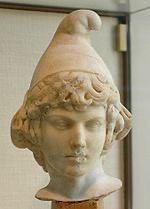The star of this chapter is a hat that has figured in the fashion and history of human head coverings for thousands of years. Originating in Asia Minor as early as five hundred years before the common era, this red felt hat went from being the symbol of outsider status to being a potent symbol of liberty, hidden in plain sight to this day on coats of arms of from Latin America to the United States Senate.

From pre-Christian Greece to 4th century Thrace in what is now Bulgaria, up to the 12th century, this hat was worn by men all over Europe. It was known as a Jewish hat when it showed up in yellow. Sometimes it has been required by law, and at other times, banned from use by law, and law has governed who can or should wear it.
In his play, Plutos, written in 388 BCE the Greek playwright, Aristophanes, specified this hat as part of the costume of King Midas, as a symbol that its wearer was an outsider, that is, a non-Greek. Midas was king of Phrygia in Central Anatolia in what is now Turkey, and this hat was common to that area. The issue of who was a Greek and who was not was a distinction of utmost importance at this time, dividing, as it did, voting members of the polis from slaves and outsiders. This would be clearly understood by anyone watching the play, because according to the myth that predated Aristophanes’ play, the great god Apollo and the playful Pan were duelists in a musical challenge, of which Midas was one of the judges. When Midas chose Pan’s music over Apollo’s, the wrathful god gave Midas donkey’s ears that he covered up by wearing this hat.
From Greek times onward, the Phrygian hat was used in art and sculpture as a short-hand to show that the person represented was from the East. For example, a mosaic mural in the Basilica of Sant’Apollinare Nuovo, Ravenna, Italy from 600 CE shows the three kings bringing their tribute with hats of this shape on their heads as symbols of the East.
How did this humble hat move from symbol of alien status to a potent sign of liberty? The answer is found in the ceremony of manumission, that is, the final step in the process of buying one’s freedom. As in early Greek times, slaves went bareheaded, but free people wore hats. At the conclusion of the ceremony that freed a slave in Rome’s Late Republic (147 BCE to 30 BCE), the new citizen entitled to wear the cone-shaped, red felt hat that marked him or her as a free person under the law. This brim-less, cone-shaped hat was called a pileus. Over time, a similar hat with a brim and a decided slouch was substituted for the cone and taken to symbolize the same thing, i.e., liberty from slavery.
In the late 1700’s, the Phrygian hat was dramatically revived as a symbol of liberty against the oppression of the ruling regimes of inherited royalty rather than election by the people, culminating in the French Revolution of 1789. In crafting the new national identity that was not based on the royal family, an attempt was made to develop an anti-coat of arms that would represent the people, not the crown. The symbol-spirit Marianne was created to personify the liberated French people, and this spirit, to this day, wears a Phrygian hat. A mid-1960’s photographic portrait shows the Marianne wearing nothing more than greasepaint and The Hat.

2009_07_01_archive.html Photo de F. Lamiot (own work), faite le 15 novembre 2006. accessed via Wikipedia
Across the ocean in the mid-1700’s, the felt hat was worn by European-Americans in the British Colonies to make a similar statement. While the Daughters of Liberty proudly wove and wore homespun cloth to make public their boycotting of British goods, revolutionary-minded men of the time wore a blue Phrygian hat as the symbol of their resistance to the British crown.
The hat, often shown on an upraised stake, or Liberty Pole, graces coat of arms of the U.S. Senate and the State of New York. Tthe Phrygian Hat migrated south during the early 1800’s and was adopted as a symbol of freedom from colonialism, eventually ending up on the coats of arms of several Latin American Countries.

In a variation on the Phrygian red hat, in 1942, the Norwegian police department of occupied Trondhiem, outlawed the wearing of the traditional red Norwegian stocking cap,[2] because it was one in a series of seemingly innocuous symbols that were banned as, each in its turn, was adopted by the populace as a symbol of resistance and Norwegian identity.
Once you know the look of The Hat, you begin to see it everywhere, from classical paintings, mosaics, and sculptures, to Disney’s seven dwarves, the Smurfs, and perhaps in eponymous hero’s wardrobe in Dr. Seuss’ 500 Hats of Bartholomew Cubbins.

